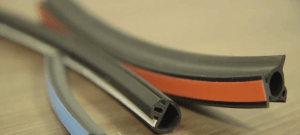Edge trim rubber is used to protect and finish exposed metal edges. Most trim seals are black and smooth, but you can also choose custom colors and textured finishes. To promote stronger gripping, edge trim can have interior tongues. Wire cores or segmented cores offer additional impact resistance. You can buy lengths of edge trim rubber in bulk and cut them yourself, or you can buy trim seals that are cut-to-size. Either way, trim seals are installed by pressing the rubber onto the edge.
Edge trim rubber is installed on car doors, truck cabs, machine guards, kitchen equipment, and other sheet metal surfaces. No matter what the application, choosing the right trim seal starts by understanding your requirements. Do you need edge trim rubber for indoor or outdoor use? Does the trim seal need to resist fluids like machine oils, or is resistance against water, weather, ozone and sunlight required? These are just some of the questions you’ll need to ask and answer.
Rubber Durometer and Core Types
Trim seals can be made from solid rubber, sponge rubber, or dual durometer rubber. Durometer, a measure of hardness, is expressed as a numeric value on the shore A scale. Solid rubber profiles in 40 durometer have the consistency of pencil erasers. At 90 durometer, they’re hard like hockey pucks. Bulb trim, a type of edge trim, can have a softer, lower durometer bulb and a harder, higher durometer retainer that you press over the flange. These rubber seals work well with low-to-medium compression force.
Edge trim rubber can contain steel wire cores or segmented steel cores that absorb impact. Because of steel’s ability to withstand impact under cold temperatures, trim seals with a steel wire core are a good choice for outdoor applications. Segmented steel cores often contain cold-rolled steel, which provides good elongation properties. Elongation, the amount that a material can stretch or extend under stress, is usually expressed as a percentage of the original length. Elongation varies by rubber material.
EPDM Edge Trim
EPDM edge trim rubber resists moisture and withstands temperature extremes. EPDM also maintains its flexibility at low temperatures, provides a relatively high degree of electrical insulation, and exhibits superior UV resistance. EPDM rubber seals resist water and steam, and provide good resistance to alkalis, acids, and oxygenated solvents. Choose EPDM edge trim rubber for car door edges, machinery, and outdoor applications.
Elasto Proxy offers fire-rated EPDM rubber trim that meets tough requirements for flame, smoke, and toxicity (FST). This fire-resistant rubber is laboratory-tested and validated for mass transit applications such as buses, subways, and rail. Elasto Proxy’s transit-grade edge trim rubber provides an alternative to neoprene, an all-purpose material with both flame and water resistance. Unlike neoprene, however, EPDM remains flexible at low temperatures.
TPE Edge Trim
TPE edge trim is made of thermoplastic elastomers (TPE), a group of rubber-like materials that combine the processing strengths of thermoplastics with the flexibility of thermoset rubbers. TPE is less likely to break in cold temperatures than polyvinyl chloride (PVC), but has a higher material cost than other rubbers. TPE rubber edge trim is lightweight, available in a variety of colors, easy-to-install, and great for window trim. It has relatively poor recovery when exposed to heat and compression, however.
Choose TPE edge trim rubber for applications that require recyclable materials, or that require fully non-metal parts. Instead of a steel core, TPE edge trim can use a solid interior plastic for a full grip. Importantly, these rubber seals meet or comply with the requirements of the European Union’s (EU) Restriction of Hazardous Substances (RoHS) directive. If you’re looking for an alternative to EPDM, you’ll find a wide variety of TPE products in Elasto Proxy’s catalog.
Silicone Edge Trim
Silicone edge trim rubber is used in applications that require low toxicity, low chemical reactivity, and thermal stability over a wide temperature range. Typically, silicone edge trim is used in food and beverage processing, medical, pharmaceutical, and other sanitary or hygienic applications. A type or family of synthetic rubbers, silicones can be specially-formulated to impart particular properties. Note, however, that some silicones are not recyclable.
How to Buy and Install Custom Trim Seals
As explained in the introduction to this article, edge trim rubber comes in lengths that you can cut yourself. You can also buy trim seals that have been cut-to-size based on your specifications. Cutting lengths of rubber in-house may seem cost-effective but using a hand tool like a wire cutter can crimp the ends and result in material waste from poor-quality cuts.
Custom-fabricated edge trim rubber from Elasto Proxy features precise cuts and clean, smooth edges. The abrasive saw blade that we use won’t put pressure on the profile either. If you still decide to make the cuts yourself, make sure to use the right tool. Also, feel for the gap between the clips if the trim seal has a segmented core. If you don’t find the right spot before cutting, the edge trim may crush and deform.
Creating mitered corners can be especially challenging. Typically, these angled cuts are made at 45° angles into the face of the edge trim. When two complementary cuts are joined together, the mating lines need to be uniform. If you’re making the cuts yourself, use a 90° miter tool rather than tin snips. Cut a notch from each leg but cut only one leg at a time.
Edge trim rubber is pressed into place over the flange. For high volume installations, you may want to use a pneumatic air hammer instead of your hands. For best results, always install lengths of edge trim so that the ends won’t separate. Push the ends together and leave some material in the loop that’s created. Then push down on the edge trim to ensure a proper fit avoid stretching.
To learn more about trim seal selection and installation, contact Elasto Proxy.









